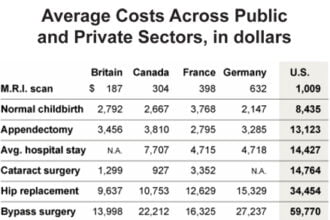The U.S. nominee to the World Bank presidency is attracting criticism from those worried about the “healthization” of the development field. In Bloomberg, my colleague Arvind Subramanian is quoted: “Someone who comes to the bank has to be much more than a health economist or a health person.”
The U.S. nominee to the World Bank presidency is attracting criticism from those worried about the “healthization” of the development field. In Bloomberg, my colleague Arvind Subramanian is quoted: “Someone who comes to the bank has to be much more than a health economist or a health person.”
“Healthization” has been going on since the early 1990s with the launch of the Global Fund and GAVI, the growth of the Bill & Melinda Gates Foundation, the creation of PEPFAR, the WHO’s Commission on Macroeconomics and Health, UNITAID, and more. Much of the big new money and organizations are related to health.
Critics argue that investing in health helps with development, but is not itself development. From this perspective, development is defined as the sustained financing and provision of all kinds of basic services to the population (water, sanitation, roads, justice, education, electricity, etc.) as well as a thriving private sector to support livelihoods, poverty reduction and government revenues. In this view, health services like vaccination and ARV are easy technology fix-its whose experience cannot be extrapolated to other basic services, while the health sector has little to say on the rest.
Yet “healthization” can’t fairly be characterized as just charity and expansive spending, a marginal field of endeavor not related to the core business. Instead, better health and nutrition are major players in the development story, and the field has lots to offer the broader enterprise. Here’s why:
- Health and nutrition status are the ultimate measures of well-being. “Happiness” economists use measures of self-reported health, correlated closely with objective indicators of health as well as happiness, as part of a core set of indicators of well-being. My colleague Charles Kenny has argued that health outcomes like life expectancy and infant mortality rates are better indicators of long-term well-being than growth and income poverty. Further, there is much evidence that more years of life and health are valued more than other consumption; the trend in public and private health expenditure mainly goes in one direction – up. If other goods are becoming cheaper and if health is a luxury good (we spend more as incomes rise), the emphasis on health is not misplaced.
- Health and nutrition have something to do with educational attainment, productivity and -by extension- growth. John Hoddinott and co-authors’ groundbreaking study in Guatemala found that improved nutrition in early childhood led to substantial increases in wage rates for men, suggesting that investments in early childhood nutrition can be long-term drivers of economic growth. Other work connects maternal and early childhood health and nutrition with improved cognitive ability and school performance. Improved health is both a cause and consequence of higher incomes; Bloom and Canning review the macroeconomic evidence here.
- As an economic sector, health is growing in importance; while the U.S. is the obvious outlier at 17% of GDP, the OECD and the upper middle-income countries are all nearing or above 8% of GDP. Because medical care is labor- intensive, it is also the source of jobs. In Turkey and Mexico, the OECD reports that about 3% of the total workforce is in health, while the OECD average is 10% of total employment in 2009. Michael Clemens’ work has illustrated how health worker migration has generated large remittances to sending countries. There is also growth in and potential for between-country trade in the health sector.
- Health has lots of lessons and experiences relevant for other sectors. The fiscal implications of health spending growth and evidence of inefficiencies have led to an emphasis on value for money, squeezing the most health and quality of care from the scarce health dollar. This agenda occupies much of the field (myself included), and is surely relevant to other sectors. From improving accountability via community report cards and new technology, to paying providers for better results, to transferring cash, vouchers and insurance to poor families to assure access to care, to more strategic procurement of inputs, the health sector has led on the rigorous testing and evaluation of program strategies to improve efficiency. The health sector is rife with problems of agency and misaligned incentives, as well as innovative solutions to these perennial issues.
- Health includes a lot of global public good concerns –prevention and control of infectious disease, research and development of medical products, management of intellectual property– likely to be central to global development agencies’ future agendas.
- Health is one of the few places we can say with confidence that development assistance has worked. From case studies to systematic reviews, there is evidence that aid-funded health programs work to improve their target outcomes. While overall there is a limited relationship, at the macro level aid spending on infectious diseases and family planning has caused reductions in mortality.
- Finally, trade-offs and uncertainty in policy and practice are part of a health economist’s daily fare. There is increasing cost-effectiveness evidence for clinical and public health decision-making, but there are always ethical, equity and other factors that need to be taken into account. Juggling these different objectives is at the center of the health enterprise and at the heart of development as well.
There are still reasons to be apprehensive about “healthization.” The health sector is the most fragmented of development aid, also prone to fads and verticality, interminable and unproductive discussions on whose health system model is “best”, donors and NGOs that build parallel systems without building government stewardship, and an annoying Omertà in some circles that sees dissent, analysis and criticism as a threat to successful advocacy and fundraising.
But on balance, “healthization” has plenty to offer the development field.
Thanks to Charles Kenny and Victoria Fan for their comments.







